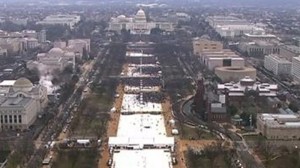The image below is doing the rounds, and it’s one that I consider with some confusion. Courtesy of CNN, the photo is an aerial shot of the crowd for the inauguration of Donald Trump as President on 20 January 2017.

Now, many will debate the legitimacy of the photo, citing the timing of the photo (ie being taken well prior to the actual proceedings), but I honestly think this is a red herring.
Aside from the fact that DC is very deep Democrat territory, and therefore fewer local people would be interested in attending the swearing in of a Republican President, the point of a low turnout has very little relevancy, I feel, to the actual process of determining policy.
The general story in the lead up to the electoral college casting their votes was to throw doubt upon the legitimacy of Trump’s election victory. There was a decidedly pointed effort to highlight that even though he won, he kinda oddly didn’t when you consider the measure that doesn’t count (ie popular vote).
Regardless of crowd turn out, and regardless of people expressing their right to free speech in marches across the United States, Trump remains stubbornly in the Oval Office, and will continue to sit there for the next four years – impeachment pending.
We appear to have another situation of George W Bush on our hands now, and the media has seemingly decided that actual inspection of policy is not the right path, but rather we paint the President as a buffoon – rightly or wrongly.
Personally, I am interested in his ideas. Like it or not, he’s in the driver’s seat. If the media chooses to not actually inform the people of his proposals, and instead focusses on his character, then I am afraid there is no helping the media. They haven’t learned their lesson, and they might doom us all to a possibility of a two-term Trump.
Don’t get me wrong, Trump ain’t gonna sail through. A lot of people who voted for him will turn on a dime if they feel he isn’t delivering. Despite a popular belief, a majority of people voted for Trump in the faith that he’ll offer something different to the staid politics of yore. Those who voted for him aren’t die-hard supporters, but those who wanted to protest. To spite.
But the media needs to avoid going for superficial attacks on him, and needs to actually go deeper. Start reporting on his policies and not the person. Maybe then they can regrow some trust in their flailing service.